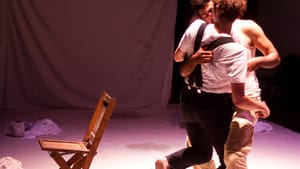Stay in the Loop
BSR publishes on a weekly schedule, with an email newsletter every Wednesday and Thursday morning. There’s no paywall, and subscribing is always free.
Coming full circle
Fringe 2015: '50 Days at Iliam' by Hannah Van Sciver

My inner art-history-dork-pretentious-art-school-snob was intrigued when I found out that Fifty Days at Iliam was a show about Cy Twombly’s monumental Fifty Days at Iliam. The room devoted to it at the Philadelphia Museum of Art is one that, as a museum employee, I frequent on lunch breaks and desk breaks and essentially any break I have during the day. The stark white room permeated by Twombly’s violent yet childish flashes of bright red and blue is one that is oddly calming, despite the violent nature of the paintings.
Hannah Van Sciver’s take on Fifty Days at Iliam was not at all what I expected, which was a dark, overdramatic interpretation of Twombly’s tortured paintings, a performance filled with violence and classical monologues. Instead, the audience was served a sensual, rhythmic, playful, and thoughtful take on the inner workings of the artist.
The audience was ushered into the intimate theater on a very humid September evening. A Greek chorus of sorts greeted the audience, humming in harmony with some gentle, Greek-inspired acoustic guitar. Seats were set up around the perimeter of a large, white, rectangular tarp with Van Sciver sitting in the center, staring intensely at a stark white sheet set up at the end of the narrow theater. Van Sciver, as Twombly, began dancing in perfect, synchronized rhythm with a woman in all white (Elizabeth Audley).
Speaking the truth
The woman, we learn, is Cassandra, the daughter of Priam and Hecuba. According to myth, she fell asleep in a temple, only to have her ears licked by snakes, which gave her the ability to hear the future. Within psychology there is something called the Cassandra Complex, in which a valid concern is dismissed or disbelieved. Twombly dances with Cassandra throughout the entire performance; she remains to be the only constant companion to Twombly’s character, the only person he seems happy to see. Delving deeper into their relationship, it can be observed that Twombly and Cassandra both consistently speak their truth and are dismissed by figures in society. They are kindred spirits.
The show chronicles Twombly’s creation of Iliam, starting in art school where a stern professor/Hector (Richard Chan) starts a 50-day lesson in drawing the “perfect circle,” which Twombly is unable to do. Only one of his classmates understands him — Robert Rauschenberg (Joseph Ahmed). We quickly begin to recognize him as Achilles, the famed war hero of Homer’s tales, who becomes his lover. Rauschenberg/Achilles is bold and confident and often protects Twombly, while at the same time trying to extract him from his artwork, so Twombly leaves him. We are reminded of the accepted homoerotic relationship between Achilles and Patroclus in Homer. In a series of epic “battles” (they begin as silly dance battles before evolving into violence), Hector and Achilles fight. In the context of the play, Rauschenberg is fighting his professor from art school, a.k.a., the classical ideas of painting. (If you’ve gone to art school, you know that actually feels like the Trojan War).
Hyper-masculinity
Twombly’s Fifty Days at Iliam paintings have huge phallic symbols with the names of Agamemnon, Achilles, Hector, and other Homeric men scrawled across the canvases. This play made sense of the emphasis on hyper-masculinity in Twombly’s series. Twombly seemed extremely uncomfortable with his sexual orientation, and it makes sense that he flees to a place — Greece — where he can make his artwork in peace, and one that is well known for an era in time when masculine icons were not penalized for engaging in same-sex relationships.
The show toggles between feelings of playfulness (mostly demonstrated by Achilles, whose character truly resembled a rooster strutting around in a field of hens) and anxious self-loathing (mostly demonstrated by the somber Cassandra). At the end of the show Twombly is seated in the center of a filthy tarp, covered in charcoal and water and looking truly like an artist after coming to a cathartic breakthrough (or perhaps the Trojan War?), gazing upon the same blank sheet from the beginning of the show. On the tarp, there is a horribly uneven circle. Twombly sits and gazes upon the circle and for the first time in the show, we see the artist in a state of self-acceptance, alone with his irregular circle.
What, When, Where
50 Days at Iliam. Produced by Hannah Van Sciver. William Steinberger directed. September 3-5, 2015. A performance of the 2015 Fringe Festival at The Asian Arts Initiative, 1219 Vine St., Philadelphia. fringearts.com or 214-413-1318.
Sign up for our newsletter
All of the week's new articles, all in one place. Sign up for the free weekly BSR newsletters, and don't miss a conversation.
